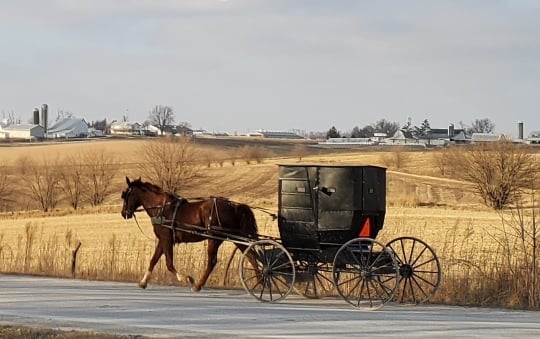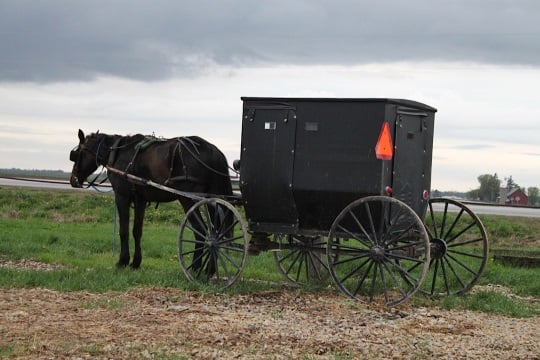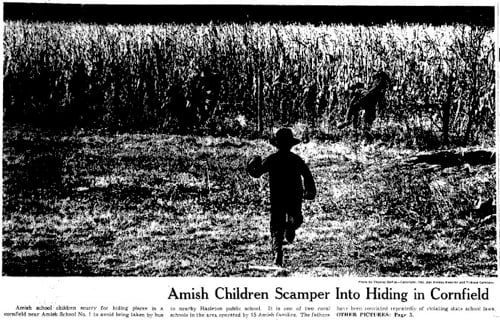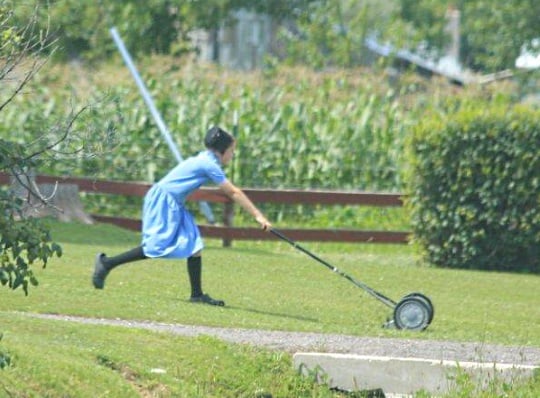Iowa Amish
Iowa has a long history of Amish settlement
 The Amish in Iowa are found most notably in three locations in the state—near the towns of Kalona, Bloomfield, and in Buchanan County. These three communities make up about half the state’s Amish population.
The Amish in Iowa are found most notably in three locations in the state—near the towns of Kalona, Bloomfield, and in Buchanan County. These three communities make up about half the state’s Amish population.
As of 2023, Iowa’s Amish population is approximately 10,200 people, spread across two dozen communities (Young Center, 2022). Updated July 31, 2023
Amish communities in Iowa include:
- Kalona – Kalona is the oldest Iowa Amish settlement
- Bloomfield – Bloomfield is the largest Amish community in the state. Amish here are of a similar affiliation to those in Kalona
- Buchanan County – the Amish at Hazleton in Buchanan County are one of the more conservative groups in Amish society, though have been changing in recent years
- Small Iowa settlements – numerous smaller settlements exist in Iowa, with about a dozen having been founded in the past 2 decades
Kalona Amish
Kalona is the oldest and best-known of all Iowa Amish settlements. Founded in 1846, Kalona has a total of 12 church districts today, and a population of over 1,600 Amish people.
The Kalona Amish settlement is set among the rolling hills of Johnson and Washington Counties in southeast Iowa. About 2/3 of the settlement located in Johnson County with the remaining 1/3 in Washington County, clustered around the small town of Kalona (pop. 2,200), a popular tourist town.

The Kalona Amish community is often reported to be the “largest Amish community west of the Mississippi”. In fact, this is not even the largest settlement in the state. And outside of Iowa, the Amish settlement at Seymour, Missouri is larger, with a population exceeding 3,000 Amish as of 2023.
At nearly 180 years in existence, Kalona is in fact one of the oldest communities in Amish society. Over the years, progressive religious movements, out-migration, and periods of increased defection rates (see Miller, The Kalona Amish: Retention and Defection Patterns of the 20th Century) have reduced the Kalona population, resulting in a fairly small Amish community relative to its age.
Comparatively, settlements started at similar times at Arthur, Illinois (1864) and Nappanee, Indiana (1841) are significantly larger in size, with populations of over 4,000 people (Arthur) and over 6,000 (Nappanee).
Farming is popular in this community. Amish farmers here operate standard cow dairies, with a significant contingent milking goats, an animal especially popular in the state for its milk. Some Amish even milk sheep in this community.

Kalona Amish are among the more progressive Old Order groups when it comes to technology. In Living Without Electricity, Stephen Scott and Kenneth Pellman note that Kalona Amish permit the use of propane gas, power lawnmowers, and rototillers. In addition to the majority Old Order presence, there is a small New Order group at Kalona as well.
Kalona Amish are also among the few Amish that allow tractors to be used for field work. However, this is with the stricture that tractors have metal wheels, so as to discourage road travel.
Amish traditionally have felt that tractors, with their four wheels, engine, and steering wheel, are not far removed from automobiles. Allowing full usage of rubber-tired tractors would only encourage eventual adoption of conventional motor vehicles. Those tractors that do venture onto the road in Kalona reveal by a loud clanking noise that they are not fit for high speeds or long distances.
Common surnames in the Kalona community include Yoder, Miller, Ropp, Brenneman, Bontrager, and Gingerich. Amish in the Kalona community are “back-and-forth” with Amish in settlements at Arthur, Illinois and northern Indiana, and most of all, with Amish at the nearby Bloomfield settlement.
Bloomfield
Bloomfield is a much younger Iowa Amish settlement located to the southwest of Kalona in Davis County. Founded in 1971, this community is larger in size than Kalona, with over 1,800 Amish people as of 2023. Bloomfield Amish churches maintain a similar, though somewhat more traditional Ordnung.

Amish settlement extends west from Bloomfield up to and beyond the hamlet of West Grove, and up to Drakesville and beyond to the north. At least eight Amish schools and one cemetery serve the Amish of this community.
Amish at Bloomfield are quite entrepreneurial, and operate a wide array of businesses. As far back as 2003, there were nearly 70 businesses in operation, averaging about one per every other Amish household (see Bloomfield Amish Community Address & Map 2003).
Numerous furniture and wood businesses, a bakery, a rug weaver, and a greenhouse are among the enterprises run by Amish (read more on Iowa Amish furniture businesses). Horseshoers (farriers), buggy shops, and a refrigerator business serve the needs of the Amish community, and in some cases non-Amish as well.
Bloomfield is the home of an Amishman paralyzed as a young man, who was later the subject of a book written by his father. Read more on the Bloomfield Amish settlement.
Buchanan County (Hazleton)
The Amish of Buchanan County differ from their cousins in the southern part of Iowa. Amish from Kalona founded this settlement near the town of Hazleton in 1914, seeking to preserve more conservative church standards. Steven Nolt in A History of the Amish describes the Buchanan County Amish as being among the most conservative in the entire Amish diaspora.

Amish here have been described in the past as among the most tradition-minded of all Amish, using limited technology. Chainsaws, inside flush toilets, pneumatic tools, and tractors for belt power have (at least in the past) not been permitted by the Amish of Buchanan County, though the majority of congregations across Amish society do allow these innovations (see Scott and Pellman’s Living Without Electricity).
However, in recent years the Amish in this community have accepted increasing amounts of change, and it would be inaccurate to call them among the most conservative groups. Acceptance of the SMV triangle, storm fronts on buggies, phone shanties, and pressure lighting place them on a more progressive tier. Amish from the Buchanan County group have founded many settlements outside of this home community, becoming one of the widest-dispersed Amish affiliations.
Amish in Buchanan County also found themselves on the forefront of education disputes in the mid-1960s. It was in Buchanan County that a famous conflict took place in the matter of Amish schooling.
Amish school conflict in Iowa
In the mid-1960s, Amish living in Buchanan County found themselves in the middle of a conflict between two rival school districts who were in the course of merging. Locals from the smaller district opposed the merger.
Amish themselves wished to be included in an area of the new district where one-room schools would still be operated. At the time Amish had also come under pressure for failing to comply with increasingly stringent teacher certification standards. The Amish were convinced by the school superintendent to vote in a local referendum in favor of merging, on promise of support for keeping one-room schools.
The Amish vote, which helped the merger measure pass, angered the minority opposition. Authorities eventually took action against the Amish, who had become involved as “unwitting pawns”, as John A. Hostetler describes them, in the larger intra-communal conflict. Amish schools were visited by state inspectors and fines levied against the Amish for employing uncertified teachers (Amish Society, John A. Hostetler, pp. 264-266).

The culmination of the Amish share in this dispute came when the Oelwein school bus arrived to transport Amish children to a new consolidated school, an action which officials expected would solve the problem. A famous photo of the incident shows Amish children scattering into nearby cornfields to avoid the forced bussing.
Amish scholar John Hostetler reports that on November 19, 1965, “school authorities forced their way into a private Amish school in order to compel the children to board a bus to take them to the consolidated town school. The press got wind of impending events and recorded the scene as frightened youngsters ran for cover in nearby cornfields and sobbing mothers and fathers were arrested for noncompliance with an Iowa school law” (Amish Society, John A. Hostetler, p. 264).
The conflict became the subject of worldwide attention, and soon after, the Iowa governor became involved in the dispute, arranging a moratorium of sorts. Outsiders stepped in to pay fines which had been levied against the Amish.
The National Committee for Amish Religious Freedom was organized by sympathetic outsiders at this time as well, and turned its attention to the issue of Amish schooling. The conflict took on a national scope with questions of religious liberty coming under discussion.
Eventually, Iowa’s state legislature changed school code to allow for religious exemptions from state school standards (Amish Society, Hostetler, pp. 267-268). The Buchanan County conflict was a key event on the road to the Wisconsin v. Yoder Supreme Court decision of 1972 which granted Amish and other groups religious exemption from state-mandated schooling standards.
Other Iowa Amish Settlements
In addition to the three large Iowa Amish settlements detailed above, numerous smaller communities exist in the Hawkeye State. Most of the remaining Amish settlements consist of one, two, or three church districts, meaning a population of anywhere from a handful of families to about 400 at most.
The community at Seymour in Wayne County, founded in the mid-1990s, is the state’s fourth largest, at nearly 1,000 Amish people.
In Van Buren County, near the towns of Milton and Pulaski, one finds an Amish settlement of five church districts, founded in 1969. Van Buren County is also home to a more recent community, founded in 2005 near Bonaparte.
Delaware County, near Edgewood, is also home to a settlement of three districts, founded in 1986. The Mitchell County settlement in the environs of McIntire and Riceville, founded 1975, had grown to two church districts as of 2008, and fifteen years later, remains about the same size.

Other Iowa Amish settlements are found in Lucas, Allamakee, Ringgold, and Decatur Counties. A number of communities have been founded by Amish since 2010, including in Madison and Monroe Counties.
The Amana people
Another Iowa religious group sometimes confused with the Amish are the Amana people.
The Amana people were a German Pietist group also known as the Community of True Inspiration. Seeking respite from religious persecution, they immigrated to New York in the early 1840’s, later moving to the rich farmlands of central Iowa in 1855, about the same time Amish were founding settlements in the state.
Amana people practiced communal living, with property held in common and individuals assigned tasks which they performed for the community. Amana people ate in common and also maintained a degree of plain dress.
A number of villages were founded by the Amana people which bear names such as Amana, West Amana, and High Amana. These villages are only a short drive from the Amish settlement at Kalona, a likely reason (along with the similar-sounding name and German heritage) for confusion between the two groups.
Due to the desire on the part of some members for greater economic and social liberties, the Amana colonies decided to cease the practice of communal property in 1932. Property and business interests were entrusted to a joint-stock company which would manage the business interests of the community.
Like the Amish, Amana people developed a reputation for industriousness, and ran a number of operations including farms, a wool mill, and a mill which produced calico, a woven cotton fabric. The refrigerator and kitchen appliance maker Amana Refrigeration was started by an Amana member in the 1930s.
Today Amana people continue church life but without communal living or other cultural markers which distinguished this society in America for nearly 90 years.
Iowa Amish settlements which no longer exist
Iowa was once home to a number of Amish settlements founded in the mid-1800s, but which have ceased to exist. All of these communities were located in the southeastern region of the state. In most cases, these settlements lost their Amish identity when congregants adopted more progressive practices and beliefs.
The first Amish to settle in what was then Iowa Territory arrived to Lee County in 1840. Numerous Amish came to this settlement from Ohio, as in Iowa they were able to find land at more affordable prices. David Luthy reports that this community ceased to exist in 1870 not because of progressive influence, but due to land ownership issues.
Many of the Amish settlers founded homes on land known as the “Half-Breed Tract”, a reservation claimed by “half-breed Indians”. Eventually Amish moved away because of problems acquiring clear title for their properties. Luthy notes that in this community were Amish with names no longer seen today, such as Klopfenstein, Roth, Bechler, and Goldsmith (Amish in America: Settlements that Failed 1840-1960, David Luthy pp. 115-116).
Other Amish settlements followed in the 1840s and 1850s, including at Jefferson and Henry Counties, Washington County, and Davis County. In each case, within a few decades Amish communities at these locations decisively chose more liberal paths, and became Mennonite bodies, reflecting a common pattern for many Amish across America at the time (Luthy, Settlements that Failed, pp. 116-120).
Iowa, a state with a long history of Amish settlement
Iowa is a state which has long had an Amish presence. Amish first arrived here in the mid-1800s, both from other Amish settlements in North America and direct from Europe.
Today, the three similarly-sized settlements at Kalona, Bloomfield, and Buchanan County maintain a significant Amish presence in the state. Amish have also found Iowa relatively attractive for new settlement, with over a dozen communities being founded since the turn of the century.
For more information, see:
- “Amish Population, 2022.” Young Center for Anabaptist and Pietist Studies, Elizabethtown College.
- Amish Population in the United States by State, County, and Settlement, 2022
- “The Kalona Amish: Retention and Defection Patterns of the 20th Century”, Erin Miller
- The Amish on the Iowa Prairie 1840 to 1910, Steven D. Reschly
- A History of the Amish, Steven M. Nolt
- The Mennonites in Iowa, Melvin Gingerich
- A Peculiar People: Iowa’s Old Order Amish, Elmer Schwieder and Dorothy Schwieder
- Living Without Electricity, Stephen Scott and Kenneth Pellman
- Bloomfield Amish Community Address & Map 2003
- Johnson-Washington County Amish Addresses 2003
- Amish Society, John A. Hostetler
- The Amish in America: Settlements That Failed 1840-1960, David Luthy
- Amish Settlements Across America: 2008, David Luthy
- http://www.amanacolonies.org/educational.htm
Photo credits: Kalona Amish buggy – Lee Annette; Amish lamp; Kalona meetinghouse- Don Burke; Amish buggy Buchanan County – Suzanne Woods Fisher; Amish school children- Thomas DeFeo/Des Moines Register; Hazleton moving sale – Carl Oliver






Is the “famous photo” of the school incident online somewhere?
Hi Janice, I haven’t been able to find it online (but admittedly did not search too hard), but it is featured in John Hostetler’s book Amish Society.
Thank you for writing about the Iowa Amish. Also, for distinguishing differences between Amish and Amanna Collanby. Sincerely, Martnha
School Project
Hi, my name is Savannah. I am doing a school project on the Amish in Iowa. i was wondering if you could give me information on the settlements. It would be great if you could send me some good websites to look at! Thank you!!! Just Email me at 17sshlutz@manson-nw.ia.k12.us! Thank you!
I know I’m fairly new to this site, Erik, so my request may have already happened. But, I would like for you to do an article on the Kansas Amish. I lived in Hutchinson, KS, many years, and would love to know more about the groups of Amish around there — Yoder, Partridge, etc. Thanks!!
Kansas Amish article
Hi Margaret, thanks for asking. I’ve actually done one already, which you can find here:
https://amishamerica.com/kansas-amish/
In fact you’ll find similar articles for each state where Amish live under the “Amish State Guide” link at the top menu. Welcome to the site!
Hi I Admire you!!
Hi I love the amish I admire you soooo much! I have to do a school prodject on Iowa Histery one of our choices were, The Amish in Iowa. So I was wondering if you could right something about how you guys live. Please send me something I have to get a very good grade to pass the 5th grade thanks!
GOD BLESS YOU,
Victoria
record inquiry
I was wondering if the Amish from Kalona / Joe Town Iowa area have records available about it’s members – say about a hundred years ago.
I am doing genealogy research and my great great grand mother ( Ella Mae Warey Dawson) left the Amish when she married Cicero Colfax Dawson – both Born in Joe Town / Kalona.
I know Ella’s Father was John Warey and grandfather was Bishop Christian Warey – who also died in Johnson County.
I was wondering if there are records of the Warey Family and why they eventually left the Amish faith.
Thanks you very much.
I don’t have any info on them leaving the Amish, but do have info on ancestor’s beyond Christian. The spelling changes a little. I share some ancestors, such as Jacob Yoder born 1760.
Marcus Yoder
Pamela, one place that might have records is Iowa Mennonite Historical Society, Lois Gugel, director, PO Box 576, Kalona, IA 52247, Telephone: (319) 656-3271. They are open from May to October, but may only answer the phone one day a week, usually Fridays.
The Iowa Mennonite Historical Society probably has more genealogical information than the Kalona Historical Village, 319-656-3232, which has the Iowa Mennonite Museum & Archives. I haven’t visited the Historical Village, so I hope this information is correct.
Christian Warey
Pamela, you may be interested to know that Christian Warey is in the book, OUR GOODLY HERITAGE, written by L. Glen Guengerich, 1984, published by East Union Mennonite Church, Kalona, Iowa, when they celebrated their church centennial of the years 1884 to 1984.
Christian Warey is mentioned on at least 11 pages in the book. He was the first minister and bishop of the East Union Mennonite Church, and is buried in the East Union Cemetery.
“The Warey Church at first consisted of seceded members from the Amish.” (according to page 41)
Quoting some from page 36 and 37:
“Noah Troyer, the ‘Sleeping Preacher,’ was among the first to leave the Old Order Amish and join in a division of dissatisfied members. This dissatisfied group of Amish members were without a real leader–they were sheep without a shepherd.”
“Noah Troyer’s sister, Mary, was the wife of Christian Warey.” Christian and Mary Warey moved to Iowa in 1884.
“Christian intended to join the Old Order Amish Church and attended their services on the first Sunday in the community, but he was not asked to preach because he had a folding top buggy and a raincoat, two conveniences not tolerated by the group. When the subject was brought up, Christian replied that he was not willing to give up anything that protected his health. The seceding Amish members and others, hearing of this, invited him to preach for them. This he did and from that time on, he served as their minister. That was the immediate start of how East Union came to be.”
Page 9: “At first they called themselves ‘Amish Mennonites’ but some thirty years later dropped ‘Amish’ from their name.”
From page 49: “Christian Warey preached in German. His last name is spelled variously by reliable writers and his own relatives. Should it be Wereye, Werie, Werey, Warye, Wary or Warey?”
http://www.gameo.org/encyclopedia/contents/E23850.html
also mentions Christian Warey and East Union Mennonite Church in Kalona, Iowa.
Hucow
I am looking for someone who is interested in the Hucow dairy farm business
Hucow
I am interested in the hucow business.
Visit to Amish school
Hi, I will be visiting Iowa from overseas with my husband & 2 children. I was wondering if we could visit an Amish community & the kids could sit in on an Amish school class. I am a qualified teacher & would love to observe too if possible??
Flower Auctions
Can anyone tell me in Hazelton Iowa when there plant and flower auctions are.Also is Fridays there only bakeing days?
Buchanan Co. Amish
Lisa, I thought Saturday was…I lived in Oelwein for 20+ years and my mom still lives there.
As far as the greenhouse, I remember going on Saturdays…but things might have changed. If you’re in the area, I would stop by Miller’s market and ask.
Hope this helps,
Christyne
flower auctions
I was at Hazelton last weekend and the amish said the flower and vegetables are sold at auction on tuesdays and fridays through the summer. Also the bakery is near the auction and they are open fridays and saturday. Nothing is open of thursday.
When you get around that area there are maps of all the businesses.
Nina
Amish history
I was trying to find my family history of the brenneman family
I have came to a halt. You might know where I can go from here?
My grandfather past away before my birth and all I know Is that his family had disowned him because he went to war. Any help would be great. They lived in wellman area.
Thank you so much in advance.
Christina
I might be able to help if i had a name, date of birth, and where the person was born.
Marcus Yoder
Newton Fehr history in Iowa
“Newton Fehr was born on Nov.11,1870.He left Council Bluffs
Iowa between 1885 and 1900 moving to Gladstone,Manitoba to
to homestead.He left at least one brother there by the name
of Al.Some say another brother left for California-time not
known or even if he got there.Newton passed away in Jan.1971”
Do you have any history on my grandfather’s family in Iowa and the circumstances of what happened that prompted his move to Canada?
Iowa Amish Restaurants
Hello,
I am from Michigan and recently moved to Ames, IA. I used to go to this awesome Amish restaurant in Middlebury, IN called the Essenhaus. I was wondering if there are any restaurants near Ames or within an hour or 2?
Thanks,
Katie
German Heritage
Hello to all. First of all this article is wonderful. My family, the Kopfs, came to Kalona from Germany in the early 1900’S. The hide away on a big boat. I have joural entries about the voyage and family line.Pretty cool stuff. I am very lucky to be here. I truly love all of this information thank you!
curious about story
I am curious to know why you had to leave Germany and hid on a boat.
Barn Boards for sale
To the most interesting culture of people:
We are a low to mid class couple trying to make ends meet by selling barn boards to various people. We hear that you are excellent people to make contact with and network with. We have various different sizes and of great quality…as well as some antique items as well. Would love to make contact with you and see what we could do to help one another.
Thank you
Carrieann Dougherty
Barn Boards for Sale
Contact me at mhartsock66@yahoo.com. I would like to discuss the antiques that you have
Thanks
Mark
Seeking visiting info
My husband & I will be celebrating our 10th Anniv & a landmark bday for me & a friend told me about Amish settlements in Iowa. I’ve greatly admired the Amish for a long time & would love to learn more & be able to buy handmade products, go to antique shops & farmers markets. Where would be the ideal spot to go? Any & all help is greatly appreciated.
Information about Kalona and Bloomfield
My husband and I are looking into visiting the Kalona and/or Bloomfield areas in late May and/or early June. Does anyone on here have any insight into places to go, things to do, etc. Particularly, are you aware of any lodging in Amish homes?
History Question
I am looking for Amish and Mennonite church history time lines. I would like ones that include the Anabaptist.
Martin, you can Google Anabaptist timeline, or buy a chart from Masthof Bookstore (610) 286-0258, http://www.masthof.com/ or visit Cory Anderson’s
http://www.beachyam.org/amishmennonites.htm
Quaker coops
Do you know if anyone is building Quaker chicken coops. They are so well built. I am looking for a closer place to Omaha, NE vs ordering from PA Amish. Please email me if anyone is interested. We are looking for sizes 5 X 6 or 5 X 8 or 6 X 8. Thank you so much. Irene
Quaker coops
Perry Gingrich phone 402-852-2349 This number will go to an answering machine. Perry constructs custom cabinets, but he might know of someone who would build you a chicken coop. He lives in the Amish community around Pawnee City, NE.
Amish School House Auction Info Needed
Wondering what time the Amish school house auction starts on Sat. May 18th near Hazleton, Iowa? Also, we have some items to sell (furniture) and wondered who the auctioneer company is to consign with? Thanks!
Auction
We have enjoyed the school house auctions at Hazelton, Iowa, in the past. Are they still scheduled for the fall and spring? If so, when is the next one? Thank you. Junelle Benter
My in-laws are from the Decatur county area. Their church recently split open and they started a new church. Two of their children stayed in the old church, one of which was married last Thursday 🙂 It was my 1st Amish wedding experience, but hopefully not my last 🙂
Also, the bride and groom meet at 7am with the bishop. (This group of Amish doesn’t turn the clocks forward in spring so 7am their time is 8am our time.) Church starts at 8 their time. Women and visitors sit in the kitchen, men in the living room. Many teenagers would just get up and walk out during service. The upstairs is open for women with babies who need to change diapers or nurse. Women are free to go up and come back as needed. The bride an groom sit on benches across from each other. They face each other. On either side of them sits a groomsman and bridesmaid. They also face each other. The 3 girls wore matching dark blue dresses. After the church part was over and the wedding began, the bride and groom held hands with the bishop. They exchanged vows. Every time that the name “Jesus Christ” was mentioned they would kind of slightly bend their knees quickly then stand straight again. After the wedding was over we went to my in-laws which was the next house down,for the meal. A variety of things are served (not a meat with 2 veggies and bread, but many different foods!). The tables were already set by the servers when we got there, but the benches had to be brought over in the wagon. After the meal, there is singing, and the bride and groom go upstairs to a bedroom to meet with visitors and receive gifts. They also pass out gifts to those who helped serve (the women received dish towels and metal spoons, the men who helped received cigars, and everyone else received candy). There is a supper served which is a completely different meal. After that is more singing and visiting. The youth (16 1/2 and older, unmarried of course) are paired up and sing songs at a bit faster pace. There is a 3rd meal served around midnight. The bride and groom stay at the bride’s parents’ house for the night. The bride and groom stay in their own room, and the 2 groomsmen and 2 bridesmaids stay in a room together (seperate beds of course). All of the dishes from the 3rd meal are left for the bride and groom to do to day after the wedding. So guess how they start off their honeymoon 🙂
One more small detail. Church started at 8am slow time and got out about 1pm slow time
Question
Brittany, are you from this area you wrote about? I have a priest friend from India that would like to visit an Amish farm before he returns to India. Any suggestions will be appreciated.
please have some one that does demolishion of hog facilities please call me mike pohle 515 222 9772 or who would I contact that might know someone
Hazelton amish school auction
Can anyone tell me what time the auction starts this Saturday?
Hazleton Auction start time?
Deb thanks for the info on the location, we don’t have the time confirmed but for what it’s worth Linda found last year’s info which had a start time of 9 am (with a pancake breakfast overlapping that, not sure if that is a yearly thing or not).
https://amishamerica.com/amish-auctions-may-2014/comment-page-1/#comment-81236
Changes in Kalona
I visit family in Iowa annually and always take a trip to Kalona. I went 2 weeks ago and noticed a number of changes. Dairy did not have cheese curds, no Amish visibly working at dairy, in fact, many did not appear to be from the U.S. Stringtown now has a new and bigger building with fewer products and much of that did not appear to be of same same high quality. Any idea of what his happening there? I will try one more trip before I give up completely. Very disappointing.
Lucas and Clarke Counties
Two questions:
Does anyone have information on the Amish group near Murray in Clarke County? It is a very small group. I am curious how long they have been there and where they may have come from originally.
Also, the Amish south of Chariton in Lucas County seem to have been leaving in droves the last few years. Anyone know why? Where are they going?
Thanks.
tupperware
I am trying to get into the amish communities do do some tupperware parties. Is there addresses that u could give me so that i could mail catlaogs and flyers to please.
Thanks
Lisa Patterson
Small Amish Settlements in Iowa
The Edgewood. Iowa settlement is in Clayton County, not Delaware. However, a group from the Edgewood settlement have split off and moved to the Delhi, Iowa area which is in Delaware County
I'm a senior non traditional andAmish driver working on my senior paper
It will be an Ethnograph of the Allamakee County Amish by me Val LIttlewolf Heike of Allamakee County Im a history major.
Sigourney Iowa Amish Community
I am a former resident of Keokuk County and upon a recent visit home, I noticed numerous Amish buggies in town. I haven’t seen anything published on this anywhere. Is this a new Amish community? Does anyone have information on the extent of Amish families moving into this area. Are these families an expansion from Bloomfield or Kalona? I didn’t see these farmers using tractors w/steel wheels as many Amish farmers do in the Kalona area. Thank you in advance for any help!
Raber’s Almanac (which includes lists of the ministers of most Amish districts in the U. S.) lists the ministers for the Sigourney District, and their addresses are from Sigourney and Harper, Ia. Sorry I don’t have more information, but I would suggest contacting the Iowa Mennonite Historical Museum and Archives at Kalona to see if they know more. I have visited that museum twice and found the staff to be helpful in answering questions I had.
Thank you so much for your help! Dave
Free wood
I have a church in Adam’s county Built-in 1870 Tons of lumber, I want the church taken down you can have all the wood.
Reference
I am looking for a recommendation for a person(s) or company that would be interested in tearing down a barn. Located near Lone Tree on highway 22. Mostly native timber.
Amish advertising phone line
A mennonite told me there is an Amish business advertising phone line that reaches all the Amish communities. The phone call cost $10.00. I was wondering if anyone had the phone number.
Thank you.
Amish advertising phone line
A mennonite told me there is an Amish business advertising phone line that reaches all the Amish communities. The phone call cost $10.00. I was wondering if anyone had the phone number.
Thank you very much.
Amish advertising phone line number
A mennonite told me there is an Amish business advertising phone line that reaches all the Amish communities. The phone call cost $10.00. I was wondering if anyone had the phone number.
Thank you very much.
The Amish project this humble and simple lifestyle, but the reality is that they have no problem reaping the monetary benefits created by a lifetime of cruelty and misery perpetrated on the unfortunate animals left to the Amish care. These poor animals are subjected to the worst kinds of cruelty. Puppy mills breed the poor females time after time, in deplorable conditions, metal crates with no padding or support on the bottoms, no bedding for warmth. Little food and virtually no exercise or affection. Horses fare no better. To the Amish, animals are simply a commodity, not a living, breathing creature who feels pain and experiences suffering. Unfortunately, the State of Iowa has a deplorable record regarding animal rights and is second in the nation for the lowest standard of puppy mills. Maybe the Amish could find it in their heart as Christians to extend some sympathy to these poor creatures who have no voice. But I highly doubt it. The hypocrisy is staggering.
I find it hypocritical that the Amish project this humble simple lifestyle, yet have no problem reaping the monetary profits gained through the deplorable suffering inflicted on animals unfortunate enough to have fallen into your care! Puppy meals create a life of endless suffering for the poor mother dogs who are simply breeding machines. The living conditions are deplorable…horses fare no better. Animals are simple a commodity to the Amish who refuse to acknowledge or just don’t care that these are sentient creatures feel pain and seek affection. Maybe you so called Christians could take a lesson from ST Francis of Assisi…be kind to animals who have no voice. However, I would bet you will continue living your hypocritical image.
Where can I get a map of the Amish Communities in Iowa